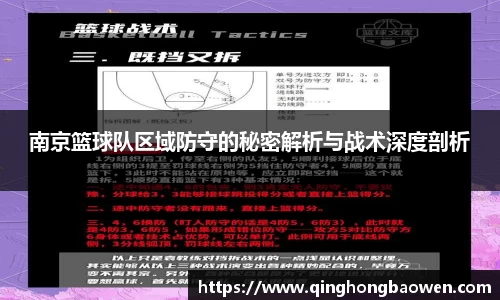南京篮球队区域防守的秘密解析与战术深度剖析
南京篮球队在近年来的比赛中,凭借其独特的区域防守战术取得了显著的成绩。本文将对南京篮球队区域防守的秘密进行深入解析,从阵型设计、球员协作、防守策略以及应对反击四个方面进行详细剖析,旨在揭示这一战术背后的深层逻辑与实际应用效果。通过分析南京篮球队如何运用区域防守来限制对手得分,并探讨其所带来的优势与不足,读者可以全面了解该球队在区域防守方面的成功经验及其战术深度。这不仅为球迷提供了更深入的理解,也为其他球队提供了可借鉴的战术思路。
1、阵型设计与布局
南京篮球队的区域防守首先体现在其独特的阵型设计上。在比赛中,他们通常采用2-3或3-2的防守阵型,这种布局能够有效地覆盖场上的主要得分区域。通过合理的位置安排,队伍能够迅速形成合围态势,使对方进攻难以展开。同时,在面对外线投射时,后卫和前锋会灵活调整位置,以确保能够及时封堵投篮。
此外,球队注重根据对手特点来调整自己的防守阵型。例如,当面对擅长突破的小个子球员时,他们会适当收缩内线,以强化禁区保护。而对于喜欢外围投射的大个子,则会加大外线包夹力度,使其难以找到舒适的出手机会。这种灵活多变的阵型设计,使得南京篮球队在不同情况下都能保持强大的防守压力。

最后,通过不断分析和总结比赛录像,教练组还针对不同对手制定专门的布置方案,使得每一场比赛都能发挥出最佳效果。这种高效且动态化的阵型设计,不仅提升了球队整体防守水平,也增强了球员之间的默契配合。
2、球员协作与沟通
在南京篮球队区域防守体系中,球员之间高度协作是成功的重要因素。每名球员都有明确的位置责任,但同时也需要根据场上的情况做出即时反应。一旦发现有空位或者对手传球意图明显,其他队友就要迅速补位,以避免破绽产生。此外,通过前场和后场之间的信息传递,可以有效地减少失误,提高整体防守效率。
这种合作并不是单纯依靠口头沟通,而是建立在长期训练和实践中的默契。当一名球员发起换位或补位时,通过眼神交流或微小动作,就能让其他人明白意图,从而形成无缝衔接。这种高度信任与默契,是南京篮球队实现成功区域防守的重要保障。
此外,在赛季中期,教练团队也特别安排了一系列非正式训练,如团建活动等,以增强团队凝聚力。这些活动不仅增加了彼此间的人际关系,也使得球队成员在关键时刻更加愿意互相帮助,共同承担责任,从而进一步提升了整个团队在比赛中的表现。
3、防守策略与调整
Nanjing basketball team’s defensive strategy focuses on adaptability and real-time adjustments. During the match, they often employ a mix of man-to-man defense with their zone defense to confuse opponents. This hybrid approach allows them to switch strategies based on how the game unfolds, effectively countering the opponent's offensive moves.
The coaching staff continuously analyzes the opposing team's strengths and weaknesses. For instance, if an opponent relies heavily on three-point shooting, the team will intensify perimeter pressure and close out quickly on shooters. Conversely, when facing teams that favor inside scoring, they tighten their interior defense to limit easy baskets in the paint.
This strategic flexibility not only disrupts opponents' offensive rhythms but also creates opportunities for fast breaks and turnovers. By forcing opponents into uncomfortable situations, Nanjing basketball team can capitalize on mistakes and convert defensive efforts into quick scoring chances.
4、应对反击与组织进攻
Nanjing basketball team's effectiveness in zone defense does not stop at just preventing points; it extends to how they transition from defense to offense after regaining possession. Once a turnover occurs or a shot is missed by the opponent, players are trained to immediately recognize the opportunity to push forward.
Their philosophy emphasizes quick ball movement and spacing during these transitions. Players sprint back downcourt while ensuring that they maintain proper spacing, allowing for quick passes that can exploit any gaps left by retreating defenders. This fast-paced transition style often catches opponents off guard, leading to high-percentage shots during fast breaks.
Moreover, players are encouraged to read the flow of play and make intelligent decisions based on their position relative to both teammates and defenders. This awareness is crucial for capitalizing on mismatches created through effective zone defense tactics. By converting defensive stops into efficient offensive plays, Nanjing basketball team maximizes their scoring potential while minimizing opponents' chances at regrouping.
总结:
Nanjing basketball team's regional defense strategy showcases a well-rounded approach that combines tactical flexibility with strong player collaboration. The careful design of defensive formations allows them not only to cover critical areas but also effectively adapt based on specific opponents’ characteristics. Meanwhile, strong communication among players ensures seamless transitions between different phases of play.
总之,通过系统性的训练和实战演练,南京篮球队已经打造出一套行之有效且具有特色的区域防御体系。本篇文章希望能为读者提供关于他们战略背后深层次理念的一些见解,同时也期待这一战术能够继续为他们带来更多胜利!

发表评论